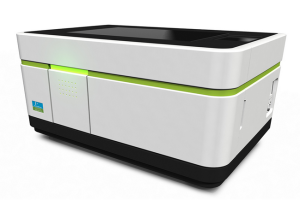Overview:
Service contact (administrators only): "EVO Portal", Perkin Elmer website.
Incubation: Heating available. CO2 controller planned-to-be-available. No humidity control: Use closed samples in excessive imaging buffer, if necessary.
Objectives: 5x, 20x, 40x (all air).
Light/optics: 4x LED light source (can activate only 1 source at the same time), 4x emission filter (UV / green / red / far-red), Spinning disc optics. 1x top-down-LED (740 nm, for morphology, using transparent-top samples).
Camera: 4.7 Megapixel sCMOS.
Light path/wavelengths
Excitation windows available:
- 365 nm (340-380 nm)
- 475 nm (460-490 nm)
- 550 nm (535-565 nm)
- 630 nm (615-645 nm)
Detection windows available:
- 430-520 nm (blue)
- 500-550 nm (green)
- 570-650 nm (red)
- 665-760 nm (far-red)
What about my specific excitation line?
For fluorophores with an excitation peak at for example 510, use the closest available light source: 475 nm
Plates:
- Manufacturer comments on plate usage: https://www.perkinelmer.com/uk/lab-products-and-services/application-support-knowledgebase/microplates/microplates-knowledge-base.html
- Machine takes "all" available cover-slip bottomed plates.
- But, do not use Techno Plastic Products (yellow stripe); which have plate-vents and cannot be supported by the holder.
- may have a glass or plastic "coverslip" bottom
- for good cell-attachment, can coat the bottom with poly-L-lysine
Skirt height
Difference between plate-edge height, and imaging surface height
Important value to enter into machine: 0-1.5 mm range allowed.
Can measure the height of unknown plates using the Operetta with the 20x objective.
- When correctly entered, objectives will never touch the plate bottom (if still; plate will be pushed upwards).
- Edge effects: Prefer not to use the outer rows and outer columns of any given plate. This because of "edge effects" (thermal, evaporation, different near the plate edge).
- Edge effects: Fill those wells with only buffer, for example.
Usage
Around the sample area:
- If the table is not powered, eject/re-insert he plate holder (software). Do not manually move table.
- Plate/sample holder is mounted on steel tracks: DO NOT CLEAN/TOUCH (if dirty, call service)
- Plate/sample holder contains a "penta-pattern" of dots, used internally for high-accuracy positioning of sample.
- Red dot on objectives needs to match the red dot on the microscope. Objectives can be manually lifted out of the system.
- With open lid, the machine counts as a class 3B laser. Close the door firmly.
- Emergency release hatch button (lid open) is on the lower right of the machine.
Plate loading:
- Start Harmony software
- Log-in with user account: personal account, with personal settings
- User accounts can only delete own data. Administrators can delete all.
The whole system is process-oriented
(re)configuration and data generation are alternating.
- Choose plate. Nomenclature = number of wells, manufacturer, type/name of plate
- Choose objective. Start at eg. 20x / 0.4 NA
- Choose operational mode (opt-mode). Confocal = spinning disc mode, with pinholes, 5% transmission of light, both ways. Epi = non-confocal, 100% transmission of light, both ways.
- Binning: (makes image size <4.7 Megapixel) → signal x4, noise x2, resolution significantly reduced.
- Live preview: eg. Show current image during stack acquisition. off = evaluate manually after setting up acquisition.
- Click "new" → new experiment.
- Set up individual channels for your fluorophores.
Arrowheads
Located under menus always reveal more detailed settings.
- Plate layout (right-most). Select wells to measure, click "SELECT". Select FOV, number, position.
- Select well-to-test.
- Clean plate-bottom with KimTech wipe and 70% Ethanol before use.
- Load plate (place within protrusions).
- or: Load slides in holder.
- or: Load slide holder into Operetta.
Setting up for imaging:
- Evaluate brightness; auto-scale and auto-contrast are always applied.
- No range-indicator (over/under exposure) is available, but a histogram for each channel is displayed
- Scaling: Normal mode: Black-to-Colour. Enhanced mode: Black-to-Colour-to-White.
- Right-click on the sample image, "show intensity". Ctrl + Click to add ROIs.
- Find focus height: Z-stack!
- Start at negative values. Go up to positive. See in "TEST IMAGES" (right of screen)
- Pick the right focus height for each channel individually.
- Next, to be certain, do focus finding in another cell. Possible plate-tilting may be revealed, and needs inspection.
Z-stacks yes/no?
It is possible to disable "use z-stack in test", to test with only single-plane images
If you want no stack acquisition upon running the actual experiment, simply select "0 planes"
- Overview picture: in the "well layout" section, select all interesting wells; right click "overview;" preview field: observe the stitched image afterwards.
- The overview picture is automatically downscaled to 200 MB in size; full-resolution stitching is not supported.
- Double-check overlap: Pull up the contrast to an extreme value (visually; right-click in the image)
- Determine whether flat-field correction will be necessary.
- "online-job" = perform image analysis during acquisition
- You can add layouts (labels) to the output data. This is an additional table.
- Re-use a plate layout (saved, from eg. editor or previous experiment); "Assay" in "define layout" (right-most).
Use overview image to pick interesting regions
Using "Test Images", and marking regions, right-click and "use as background for well" for a visual aid for selecting further regions.
Run the experiment:
- Evaluate that the correct assay is loaded.
- Name the plate and add keywords.
- → Start! And observe live-preview images during acquisition (when enabled)
- Select the whole plate, right-click, organise images in "realistic" (corresponding to the plate) or "packed" (best for display) layouts
Flat-field correction
The software can do flat-field correction based on acquired images, provided that foreground/background and areas without cells are present.
This also works in wells filled with tissue, or more-than-confluent cell cultures.
- When done: open the lid (settings - Operetta CLS - open) and remove plate/slide holder.
Image processing and analysis:
Loose info pieces:
Z-steps always > 100 nm
Fluorescent staining strategy:
To facilitate auto-detection in subsequent image analysis steps:
a) stain cells with target marker
b) stain cytosol separately (eg. CellMask Blue)
c) stain nuclei separately
Computer attached to the microscope:
DO NOT SWITCH OFF!
The PC is running a live image data and image analysis server.

